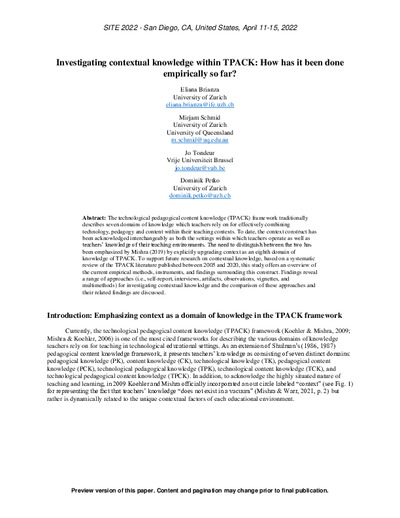 Diese Seite wurde seit mehr als 8 Monaten inhaltlich nicht mehr aktualisiert.
Unter Umständen ist sie nicht mehr aktuell.
Diese Seite wurde seit mehr als 8 Monaten inhaltlich nicht mehr aktualisiert.
Unter Umständen ist sie nicht mehr aktuell.
 Zusammenfassungen
Zusammenfassungen
 The technological pedagogical content knowledge (TPACK) framework traditionally describes seven domains of knowledge which teachers rely on for effectively combining technology, pedagogy and content within their teaching contexts. To date, the context construct has been acknowledged interchangeably as both the settings within which teachers operate as well as teachers’ knowledge of their teaching environments. The need to distinguish between the two has been emphasized by Mishra (2019) by explicitly upgrading context as an eighth domain of knowledge of TPACK. To support future research on contextual knowledge, based on a systematic review of the TPACK literature published between 2005 and 2020, this study offers an overview of the current empirical methods, instruments, and findings surrounding this construct. Findings reveal a range of approaches (i.e., self-report, interviews, artifacts, observations, vignettes, and multimethods) for investigating contextual knowledge and the comparison of these approaches and their related findings are discussed.
The technological pedagogical content knowledge (TPACK) framework traditionally describes seven domains of knowledge which teachers rely on for effectively combining technology, pedagogy and content within their teaching contexts. To date, the context construct has been acknowledged interchangeably as both the settings within which teachers operate as well as teachers’ knowledge of their teaching environments. The need to distinguish between the two has been emphasized by Mishra (2019) by explicitly upgrading context as an eighth domain of knowledge of TPACK. To support future research on contextual knowledge, based on a systematic review of the TPACK literature published between 2005 and 2020, this study offers an overview of the current empirical methods, instruments, and findings surrounding this construct. Findings reveal a range of approaches (i.e., self-report, interviews, artifacts, observations, vignettes, and multimethods) for investigating contextual knowledge and the comparison of these approaches and their related findings are discussed. Dieses Konferenz-Paper erwähnt ...
Dieses Konferenz-Paper erwähnt ...
 Tagcloud
Tagcloud
 Zitationsgraph
Zitationsgraph
 Zitationsgraph (Beta-Test mit vis.js)
Zitationsgraph (Beta-Test mit vis.js)
 1 Erwähnungen
1 Erwähnungen 
- TPACK in Context - An Updated Model (Dominik Petko, Punya Mishra, Matthew J Koehler) (2025)


 Volltext dieses Dokuments
Volltext dieses Dokuments
 |  Investigating contextual knowledge within TPACK: Artikel als Volltext ( Investigating contextual knowledge within TPACK: Artikel als Volltext ( : :  , 488 kByte; , 488 kByte;  : :  ) ) |
 Anderswo suchen
Anderswo suchen 
 Beat und dieses Konferenz-Paper
Beat und dieses Konferenz-Paper
Beat hat Dieses Konferenz-Paper während seiner Zeit am Institut für Medien und Schule (IMS) ins Biblionetz aufgenommen. Beat besitzt kein physisches, aber ein digitales Exemplar. Eine digitale Version ist auf dem Internet verfügbar (s.o.). Es gibt bisher nur wenige Objekte im Biblionetz, die dieses Werk zitieren.










 TPCK-Modell
TPCK-Modell



 Biblionetz-History
Biblionetz-History